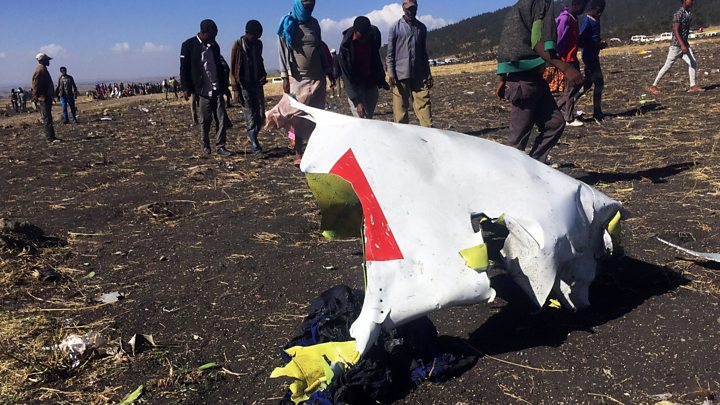Boeing faces questions after Ethiopia crash
US plane maker Boeing faces questions after an Ethiopian Airlines 737 crash on Sunday killed all 157 people on board.
It was the second crash in five months involving a 737 Max 8, the newest version of the plane.
Comparisons are being drawn with a Lion Air accident last October where the plane lost altitude soon after takeoff.
However, experts warn it is too early to say what caused the Ethiopian Airlines disaster.
How did Sunday’s accident happen?
Ethiopian Airlines says the plane, flight ET302, crashed at 08:44 local time (05:44 GMT), just six minutes after it left Addis Ababa. The aircraft, bound for Nairobi, came down near the town of Bishoftu, 60km (37 miles) south-east of the capital.
The pilot had reported difficulties and had asked to return to Addis Ababa, the airline said.
“At this stage, we cannot rule out anything,” Ethiopian Airlines CEO Tewolde Gebremariam told reporters at Bole International Airport in the capital.
Visibility was said to be good but air traffic monitor Flightradar24 reported that the plane’s “vertical speed was unstable after take-off”.
The pilot was named as Senior Captain Yared Getachew who had a “commendable performance” with more than 8,000 hours in the air, the airline said.
Passengers from more than 30 countries were on board the flight, including 32 Kenyans, 18 Canadians, and seven Britons.
At least 19 victims were affiliated with the United Nations, according a UN official.
Slovak MP Anton Hrnko also confirmed via Facebook that his wife and two children were on the plane.
In response to the accident, Ethiopia has declared Monday a national day of mourning.
What do we know about the plane?
The 737 Max-8 aircraft is relatively new to the skies, having only been in commercial use since 2017.
The plane that crashed was among six of 30 that Ethiopian Airlines had ordered as part of its expansion. It underwent a “rigorous first check maintenance” on 4 February, the airline tweeted.
Boeing said it was “deeply saddened” by the crash and is sending a team to provide technical assistance.
Following the Lion Air crash last October, investigators said the pilots had appeared to struggle with an automated system designed to keep the plane from stalling – a new feature of the Boeing 737 Max.
The anti-stalling system repeatedly forced the plane’s nose down, despite efforts by pilots to correct this, findings suggest. The crash killed 189 people.
The Lion Air plane was also new and the accident happened soon after take-off.
“It’s highly suspicious,” Mary Schiavo, former Inspector General of the US Transportation Department, told CNN.
“Here we have a brand-new aircraft that’s gone down twice in a year. That rings alarm bells in the aviation industry, because that just doesn’t happen.”
After last October’s crash, Boeing sent an emergency notice to airlines warning them of a problem with the anti-stalling system.
Boeing is expected to release a software patch to the system to deal with this issue, according to Reuters.
Andrew Blackie, an aviation safety consultant and former commercial pilot, told Associated Press that system changes “may have not been not been particularly well explained to the operating crew.”
“[But] if you look across the history of aviation it’s not hugely unusual for there to be a spike in accident rates when a new aircraft type is introduced into service.”
However, with the Ethiopian Airlines investigation at an early stage, it is not clear whether the anti-stalling system was the cause of Sunday’s crash. Aviation experts say other technical issues or human error cannot be discounted.
Ethiopian Airlines has a good safety reputation, although in 2010 one of the company’s aeroplanes crashed in the Mediterranean Sea shortly after leaving Beirut.
What happens next?
The investigation will be led by Ethiopian authorities co-ordinating with teams of experts from Boeing and the US National Transportation Safety Board.
An urgent priority for investigators will be to find the plane’s two cockpit recorders – one for data and another for pilots’ voice recordings.
Ethiopian Airlines said it would continue to fly its fleet of 737 MAX 8s since the cause of the crash has not yet been determined.
In contrast, Cayman Airways said in a statement that it has grounded its two 737 MAX 8s “until more information is received.”
Several North American airlines operate the same aircraft and have said they are monitoring the investigation. Southwest Airlines flies 31, while American Airlines and Air Canada each have 24 in their fleet.
Are you near the airport or in Bishoftu? If you witnessed the crash please email [email protected].
Please include a contact number if you are willing to speak to a BBC journalist. You can also contact us in the following ways:
Or use the form below
If you are happy to be contacted by a BBC journalist please leave a telephone number that we can
contact you on. In some cases a selection of your comments will be published, displaying your name as
you provide it and location, unless you state otherwise. Your contact details will never be published.
When sending us pictures, video or eyewitness accounts at no time should you endanger yourself or others,
take any unnecessary risks or infringe any laws. Please ensure you have read the terms and conditions.
Terms and conditions
The BBC’s Privacy Policy
Source: Read Full Article



